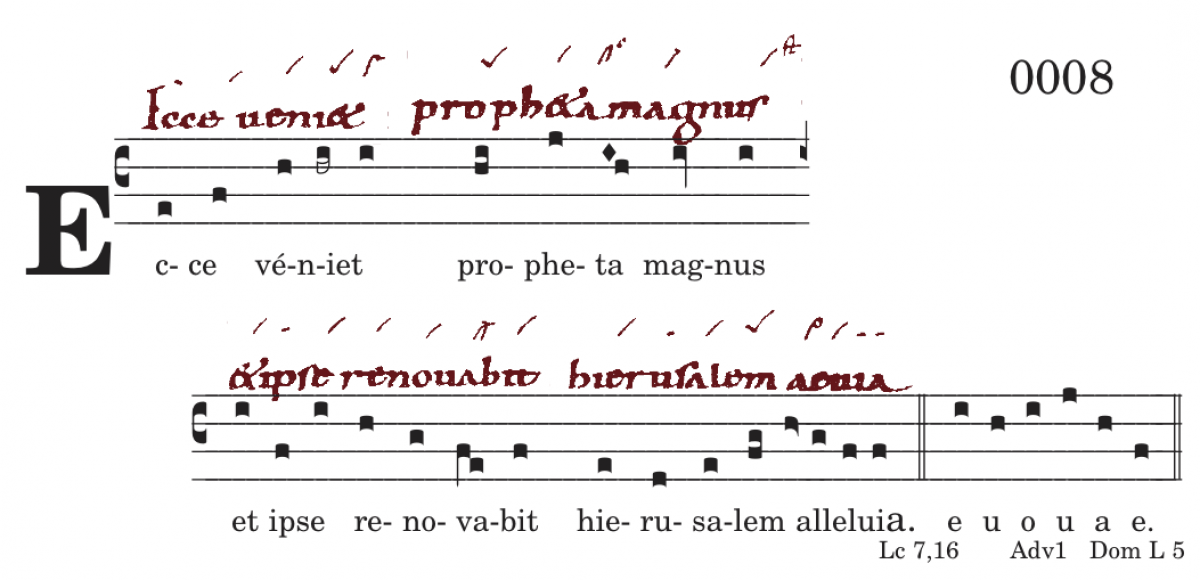Benutzer-Werkzeuge
🔘 IN GR TR AL OF CO xxxxx 1️⃣ 2️⃣ ✅ 3️⃣ 4️⃣ 5️⃣ 6️⃣ 7️⃣ 8️⃣ xxxxx AN RP IV alia
0008 AN Ecce veniet prophetaModus Q
↖️
Erstes Erscheinen dieses Typos. Der Melodieverlauf = die Textstruktur ist normal.
Die Virga strata zeigt im Q TYPOS (Protus zur Quart) den Übergang zum Cento QMED an, wenn dieser nicht unsonisch anschließt! Keine Handschrift schreibt hier zwei Töne, man könnte die Oriscusgraphie in Bv1 allerdings als Tonwiederholung missverstehen. Mz hat eine Virga strata-Graphie ähnlich H.
QINC 2acc.
~Vrg mut, Nur das AM liest die VrgStr als Bipunctum.
QMED statim: abschließen, aber sofort weitergehen.
QNOV
QTER
Die Frage nach dem „si / sa“. Die älteren Handschriften Tol + Bv, H + MR geben keine Auskunft dazu, diejenigen die si/sa notieren (Wc, Lc, Ka), sind so jung, dass sie zur ursprünglichen Tonalität keine Aussage machen können. Sie schreiben pratkisch immer „sa“ (Protus transpositus). Vor der Jahrtausendwende war dieser Typos aber, wie heute, ein Protus von der Quart und damit mit „si“ zu notieren. Vielleicht ist Zw ein Hinweis: die Zisterzienser deuten diese Antiphonen zum 7. Modus um. Damit ist „si“ festgeschrieben. Zu Lc siehe Kommentar 0139.
„hierusa-lem“ Wc „sa“ (a.m.?), Lc ?, Ka „sa“ per transpositionem.
● Siehe, es kommt ein großer Prophet er selbst wird Jerusalem erneuern. Halleluja.
● Behold, a great prophet is coming he himself will renew Jerusalem. Hallelujah.
First appearance of this type. The melodic progression = the text structure is normal.
The Virga strata in the Q TYPOS (protus to the fourth) indicates the transition to the cento QMED, if it does not follow unsonically! No manuscript writes two tones here, but the oriscus graphic in Bv1 could be misinterpreted as a tone repetition. Mz has a virga strata graphy similar to H.
QINC 2acc.
~Vrg mut, only the AM reads the VrgStr as a bipunctum.
QMED statim: finalise, but continue immediately.
QNOV
QTER
The question of the „si / sa „. The older manuscripts Tol + Bv, H + MR do not provide any information on this, those that note si/sa (Wc, Lc, Ka) are so young that they cannot make any statement on the original tonality. They always write „sa“ in Pratkian (protus transpositus). Before the turn of the millennium, however, this typos was, as today, a protus from the fourth and thus notated with „si“. Perhaps Zw is a clue: the Cistercians reinterpreted these antiphons as the 7th mode. Thus „si“ is fixed. For Lc, see comment 0139.
„hierusa-lem“ Wc „sa“ (a.m.?), Lc ?, Ka „sa“ per transpositionem.

